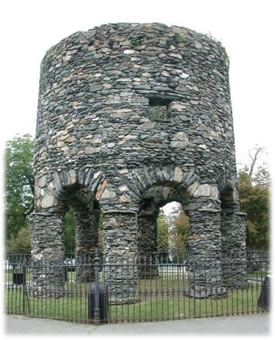
Newport Tower, Newport Rhode Island
The city of Newport, Rhode Island hosts one of America’s true great mysteries, the Newport Tower. Located in Touro Park, the tower is an odd structure of 28 feet tall, 24 feet wide with a diameter that ranges between 22 feet, 2 inches and 23 feet, 3 inches. The history of the tower is jumbled at best, however it is known that the property was once owned by Governor Benedict Arnold, the great-grandfather of Benedict Arnold, the Revolutionary War traitor. In his will dated 1677, Arnold makes reference to his “stone built Wind Mill” but most historians do not believe that Arnold built the structure (who came to the colonies in 1651) but rather rebuilt it so it could be used as a windmill.
Through the years, testing and comparison tests have been done on the structure’s mortar in an attempt to discover its age and origin. Carbon 14 dating places the age of the structure between 1635 and 1698. Excavations of the site in the 1940’s turned up many artifacts which dated from the early colonial period (1640’s) to the early part of the twentieth century. It has been suggested that the structure has been used for many things through the centuries, including Arnold’s windmill and a hay storage barn.
Some historians believe that the Newport Tower dates back to an even earlier time period citing the Piri Reis Map of 1513 that not only depicts a settlement at modern-day Newport but the tower as well. Some other theories about the tower that reach back even further.
Further in history have it being built by Norse Vikings who, it is believed by some, explored and settled in the northeastern region of North America. Although there is no hard evidence to support these claims a few points that are noteworthy exist. The structure’s windows have astronomical alignments with the summer solstice and important stars as well as a strange symbol carved into one stone, described as a hooked X. The hooked X has also been found at medieval sights in Scotland, England, Scandinavian and most notably, the Kensington Runestone.

Kensington Runestone’s
The Kensington Runestone’s connection to the Newport Tower has never been proven however the theories regarding their connection make for very good strange history.
In 1898, Olof Ohman, a Minnesota farmer, uncovered a stone which measured 31 inches high, 16 inches wide, 6 inches thick and weighed approximately 200 pounds. The stone had a strange inscription on it. Olof believed that he had an ancient Indian artifact until 1907 when Hjalmer R. Holand, a graduate student, translated the inscription. It reads,
“8 Goths and 22 Norweigans on exploration journey from Vinland over the west. We camp by 2 skerries one day-journey from this stone. We were and fished one day. After we came home, 10 men red with blood and tourtured. Hail Virgin Mary, save from evil. Have 10 men by the sea to look after our ship, 14 day -journeys from this island year 1362."
Debates have raged for over a century as to the age and validity of the Kensington Runestone, however there still seems to be no definitive answer. This has opened the door to a great deal of speculation. The leading train of thought is that the inscriptions on the runestone and the Newport Tower, both of which contain the hooked X, were relics of Norse Viking expeditions into the interior of North America. This means that Europeans were on the continent for 130 years before Christopher Columbus began his voyages.
